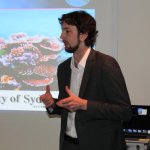Professor Larkum Visits Mandelbaum House
On the 18th of April, Mandelbaum House welcomed Professor Tony Larkum as a guest speaker at Formal Dinner. The topic of the evening was coral bleaching, a phenomenon that has devastated the world’s coral reefs in recent years. Professor Larkum is a distinguished marine biologist and an expert on coral biology and ecology. His speech touched on many topics, including the Great Barrier Reef, Charles Darwin’s theory on coral reefs, and mass coral bleaching in our oceans.
Professor Larkun began his talk by relating the Jewish people’s exodus from Egypt to the coral reef, as it was just the Passover holiday. Looking at their journey from Egypt to Canaan, they needed to cross the Red Sea and did so by the sea “splitting.” It’s clear, said Larkun, that the Israelites must have seen many coral reefs on their journey through the sea. How cool is that- these magnificent reefs have been around for thousands of years, and even the Israelites witnessed their beauty when leaving Egypt. That made me even more interested in how we can save them.
Larkun outlined the history and evolution of coral reefs in his presentation. While coral is an old species, its “birth” is relatively recent in the grand scheme of evolution, only 200 million years ago. They began growing in tropical and subtropical oceans and only started appearing in Australia about 800,000 years ago.
Charles Darwin’s theory of coral reefs was revolutionary for its time, but it now lays the foundation for our understanding of this unique ecosystem. The approach outlined the three stages that coral reefs grow: first, they grow along the shoreline as a fringing reef; then, the landline subsides, and the reef becomes a barrier; finally, if the land continues to decline, it may form an atoll.
Coral adjusts to the ambient temperature around it, usually 25℃. But when temperatures rise above 30℃, the coral begins to lose their vibrant colour and become white or pale. This is known as coral bleaching. Corals are tiny animals that live in symbiosis with algae called zooxanthellae, which live within their tissues and provide them with food and oxygen through photosynthesis. When corals are under stress from high water temperatures, they expel the algae, causing the coral to lose its colour and appear white or pale. Without the algae, the coral becomes weakened and more susceptible to disease. If the stress continues, the coral dies, and the reef ecosystem it supports may become severely damaged.
In 2016, the Great Barrier Reef experienced severe bleaching due to higher-than-normal sea temperatures. By 2018, the entire Reef had been affected by coral bleaching. That’s over 2,000 kilometres of coral. Larkun called coral bleaching the “canary in the coal mine:” Coral bleaching is the first global biological sign of global warming, while incidents like melting glaciers are physical signs.
There are still questions about coral bleaching, and we have much to learn about the Great Barrier Reef. Hundreds of species of coral are dying, and it’s not stopping any time soon. While scientific communities are working hard to solve the problem, there are many ways to go about it. Many of the possible answers are logistically complicated. For instance, scientists may be able to identify heat-resistant corals and distribute these across the reef. Or, genetically engineer corals to become heat resistant. The good news: over hundreds of years, coral will begin to adapt to warmer temperatures and will be able to survive. But when will that happen, and can scientists help the process? That we don’t yet know.
Article by: Brenna Pearlstein, Mandelbaum resident
Photography: Annika Oakley, Mandelbaum resident










